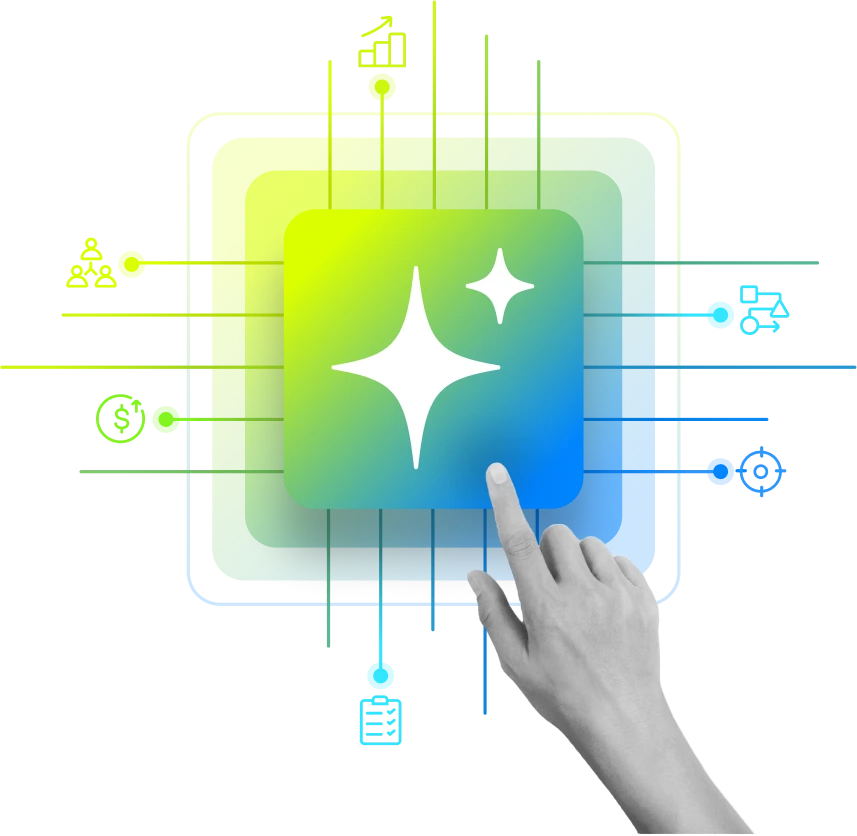The traditional sales tech stack is dying, and there’s no denying it!
How sales tech has been built, integrated, and expected to deliver results over the past two decades is fundamentally changing. Sales and revenue teams have been focused on solving specific challenges, one at a time.
When lead qualification became complex, they added a lead scoring tool. When pipeline visibility suffered, they integrated forecasting software. When outreach needed scaling, they layered on sequence automation.
Each solution worked. Each solved a real problem. But inadvertently, they created something else entirely.
What started as targeted problem-solving has evolved into a layered system of 12-15 disconnected tools that work while balancing both efficiency and chaos. The best sales ops professionals today, the ones commanding top salaries, are those who can navigate these complex integrations, understanding which tools operate at which layer and how they interconnect.
But here’s the reality. Even the most skilled ops teams are drowning in complexity.
The Hidden Cost of Tool Proliferation: A Sales Ops Nightmare
If a sales leader needs specific data, the number of calls a particular rep made for a specific campaign cohort. Simple request, right?
Not when your data lives across Salesforce, Outreach, Gong, and your attribution platform. The sales ops manager discovers that pulling this report requires touching four different systems, three API connections, and two manual exports. What should be a 10-minute task becomes a half-day project.
Take another scenario. Your team wants to swap your current ABM tool for something more advanced. However, the current tool feeds data into your CRM, which triggers sequences in your outreach platform and logs activities that your conversation intelligence tool analyzes. The integration layers run so deep that a “simple” tool swap would require rebuilding your entire workflow architecture.
This is the daily reality for sales operations teams. They’re not just managing tools; they’re maintaining a fragile ecosystem where one small change can trigger workflow chaos across multiple applications. The turnaround time for any modification is painfully high, and the stress of managing these interconnected systems has become a significant burden.
Our sympathies are with the ops teams holding this complex machinery together.
The Wave of AI: A $2.6 Trillion Transformation Ahead
McKinsey’s latest research reveals a staggering prediction: AI adoption in sales could increase global GDP by $1.4 trillion to $2.6 trillion over the next three years.
This isn’t about incremental improvements. This economic transformation is happening at scale, driven by organizations fundamentally rethinking how sales technology should work.
The company’s positioning for growth isn’t just adding AI features to existing systems but building toward AI-native sales operations. And early indicators suggest this approach will enable organizations to:
- Analyze massive data volumes to surface buying intent signals before prospects realize they’re ready to buy.
- Generate personalized outreach that could achieve significantly higher conversion rates than traditional approaches.
- Predict deal outcomes with greater accuracy, months before closure
While this transformation unfolds, many sales ops teams still debate basic CRM feature upgrades.
It’s time we stopped limiting ourselves to thinking that AI is just the future, or treating AI as merely another feature.
In reality, AI will become the infrastructure on which sales processes are built. We’re moving toward AI-first processes that will redefine how much human intervention is needed and reshape sales roles entirely.
Why Your Current Sales Stack Works Against You
Walk into any B2B sales organization today, and you’ll find the same painful reality: sales reps spend 65% of their time on non-selling activities. Data entry, tool-switching, manual research, and administrative tasks, ironically performed on the tools designed to help them sell.
The problem runs deeper than efficiency.
Traditional sales tech was built on the assumption that human intelligence could process, prioritize, and act on all available data. However, that assumption broke around 2020, when customer data volume doubled every 12 months.
Today’s sales reps are drowning in information while starving for insight.
Your CRM tracks every interaction but can’t tell you which prospect will most likely buy next month. Your email platform logs every response but can’t detect the subtle sentiment shifts that signal a deal going off-track. Your conversation intelligence tool records every call but can’t predict which coaching intervention will actually improve performance.
More data doesn’t equal more insight.
The Intelligence Revolution: How AI Will Change Everything
The AI wave will create entirely new capabilities that are impossible with traditional sales technology.
-
Predictive Prospecting That Could Eliminate Cold Outreach
Traditional prospecting relies on demographic data and behavioral triggers that are weeks or months old. AI-powered prospecting will analyze real-time signals across thousands of data sources to identify prospects actively researching solutions.
The AI Edge: Instead of 2% response rates on cold emails, organizations using these systems are reporting 15-20% response rates because they’re reaching prospects at precisely the right moment in their buying journey.
Source: Early implementations reported in HubSpot and Salesforce case studies
-
Real-Time Sales Coaching That Will Actually Work
Instead of quarterly reviews based on static scorecards, AI-powered platforms will analyze every sales conversation in real-time. They’ll detect when a rep is talking too much, missing buying signals, or failing to address objections effectively. The coaching will happen during the call, not weeks later.
The AI Edge: One global SaaS company implementing AI-driven conversation intelligence saw its average deal size increase by 23% within six months.
Source: Salesforce Einstein Analytics case study
-
Pipeline Management That Will See Around Corners
CRM-based pipeline management is reactive. It tells you what happened, not what’s about to happen. AI-powered pipeline intelligence will combine deal data with external signals, stakeholder behavior, and historical patterns to predict deal outcomes before they become apparent.
The AI Edge: Companies testing AI-driven pipeline management report 40% more accurate forecasting and 27% faster deal velocity. They can intervene in at-risk deals before they stall and accelerate promising opportunities before competitors notice them.
Source: Multiple implementations tracked in Salesforce Ben research
-
The End of Tool Proliferation: A Unified Future
Most sales leaders miss this crucial point. The future of sales tech will create more intelligent systems that work faster and provide insights faster.
The average sales organization uses 12-15 tools in its tech stack. Each tool generates data. Each requires training. Each creates friction between systems. They promise integration, but deliver fragmentation.
AI will change this dynamic.
Instead of multiple point solutions, AI-native revenue operations platforms will create unified intelligence layers that connect every customer interaction, analyze every data point, and orchestrate every sales activity through a single intelligent system.
This adds an intelligence layer that will make all your tools work together as they never could.
What This Will Look Like in Practice: The Promised Land
Here’s the sales reality that AI-native platforms will eventually deliver:
Your CRM will stop being a data repository and become a decision engine that tells you which accounts to prioritize today
Your prospecting tools will stop generating lists and start identifying prospects ready to buy in the next 30 days
Your conversation intelligence will stop creating transcripts and start providing real-time guidance that improves every sales interaction
Your forecasting will stop being guesswork and become predictive intelligence that helps you allocate resources more effectively
A Practical Blueprint: Traditional Setup vs. AI-Enhanced Stack
Traditional B2B Sales Stack:
CRM: Salesforce/HubSpot
Outreach: Outreach.io/Outplay
ABM: 6sense/Demandbase
Conversation Intelligence: Gong/Chorus
Enrichment: ZoomInfo/Apollo
Analytics: Tableau/Looker
AI-Enhanced Approach: Replace 3-4 point solutions with AI-native platforms that combine capabilities:
Unified Revenue Platform with built-in AI (consolidates CRM + outreach + analytics)
AI-powered ABM tool that integrates natively with your main platform
Conversation intelligence with real-time coaching capabilities
The goal is intelligent tools that eliminate the integration complexity plagues sales ops teams.
The Competitive Advantage That AI Will Create
Organizations that embrace AI-native sales operations will create sustainable competitive advantages that become harder to replicate over time.
The more data an AI system processes, the more intelligent it becomes. The more intelligent it becomes, the better its results, and the more organizations will want to use it.
This creates a flywheel effect where AI-native sales platforms become exponentially more powerful over time, while traditional sales tech remains linear in its capabilities.
Companies that start this flywheel early will gain compound advantages that become virtually impossible for competitors to overcome.
Three Critical Decisions Every Sales Leader Must Make Today
The AI transformation of sales tech is inevitable. However, the timeline and competitive impact depend on your decisions today.
Decision 1: Integration vs. Native AI Platforms
Will you add AI features to your existing tech stack or transition to AI-native platforms that redesign sales operations from the ground up?
The integration approach feels safer but will limit AI’s transformative potential. The native approach requires more change management but could unlock exponential improvements.
Note: Current data comparing these approaches is limited, as most AI-native platforms are still emerging. However, early implementations suggest significant advantages in workflow efficiency and data connectivity.
Decision 2: Automation vs. Augmentation
Will you use AI to automate repetitive tasks, or will you use it to augment human intelligence and decision-making?
Automation delivers efficiency gains. Augmentation could deliver competitive advantages.
Decision 3: Reactive vs. Predictive
Will you use AI to analyze what happened, or will you use it to predict and influence what’s about to happen?
Reactive AI improves reporting. Predictive AI has the potential to transform outcomes.
The Revenue Reality Check
AI represents the bridge between data collection and revenue generation.
Your current sales stack generates terabytes of data but can’t answer the most basic revenue questions: Which deals will actually close? Which accounts are ready to expand? Which prospects are worth your reps’ time?
AI will close this gap by connecting every data point to revenue outcomes through predictive intelligence that changes decisions.
When your system can tell you that Account A has a 73% expansion probability in the next 90 days while Account B has just 12%, decision-making becomes dramatically simpler.
That difference will become the strategic advantage that compounds over time.
The AI Wave: Ride It or Get Swept Away
Every technological wave follows the same pattern: early adopters ride it to dominance, while late movers get buried beneath it.
The AI wave in sales isn’t different. It’s just faster and more unforgiving.
Right now, you’re watching the wave build. Some organizations are already paddling hard, positioning themselves to catch it at the perfect moment. Others are standing on the shore, debating whether the wave is real.
But waves don’t wait for consensus.
In 18 months, the organizations riding this wave will have AI systems that learn, predict, and execute at speeds that make traditional sales operations look like they’re moving in slow motion. They’ll close deals faster, expand accounts deeper, and identify opportunities earlier than anyone operating with legacy sales tech.
Finally, work-life balance may return to sales ops teams, which won’t need to maintain complex, fragile integrations.
The choice is yours: You can’t fight a wave or wait for it. You can only decide whether to ride it or get swept away by it.
Looking for an AI-powered, all-inclusive platform that can handle most of your sales and campaign use cases? The future belongs to unified intelligence platforms that eliminate the integration complexity while delivering the AI-first capabilities your revenue team needs to stay competitive.

